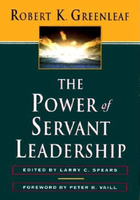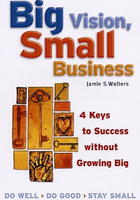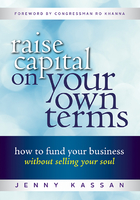YOU CAN RAISE CAPITAL ON YOUR OWN TERMS
Entrepreneurs are heroes.
You have a dream to make a difference in the world with your product or service and make money doing it. Lots of people have dreams like that. But you are bold enough to do what it takes to turn that dream into reality.
Being an entrepreneur is not easy, but every year, hundreds of thousands of men and women in the United States decide to take a risk and start a new business.
We small business owners quickly realize that outside funding is necessary, or at least highly desirable, for our businesses to get off the ground, operate until they break even, and grow to their ideal size.
Many of us turn to our personal resources and assets as a source of business funding. We may use personal credit cards, get loans from family members, take out second and third mortgages, drive Uber, or list our spare rooms on Airbnb. We also operate on a very tight budget. We buy low-quality equipment, try to build our own websites, forgo a salary, put a moratorium on family dinners out, and generally tighten our belts for the sake of our businesses.
What we entrepreneurs need is funding that does not require sacrificing our personal credit rating, our health, our energy, or our well-being.
WHAT ARE THE RISKS OF RAISING FUNDING?
Unfortunately, we may shy away from seeking outside funding because of the stories we hear about the risks of bringing on outside investors.
The story of Ben & Jerry's Homemade Ice Cream is a cautionary tale of how raising funding can take your business in a direction you never intended. There are numerous such stories of mission-driven, idealistic founders losing control of their companies, only to see them begin to shed many of the things that made them great in the first place. It's stories like these that make many entrepreneurs hesitant to raise money.
Ben Cohen and Jerry Greenfield opened their first ice cream shop in Burlington, Vermont, in 1978. From the beginning, they cared about more than just profit. Ben & Jerry's “measured its own success by asking: ‘How much have we improved the quality of life in the community? And how much profit is left over at the end of each month. If we haven't contributed to both those objectives, we have failed.' . . . For its ‘Chocolate Fudge Brownie' ice cream, Ben & Jerry's purchased brownies from Greyston Bakery, an entity whose ‘mission is to provide employment and support services to former homeless, low-income and disenfranchised people and their families.'”[1]
In 1984, they offered stock to Vermont residents—about eighteen hundred households became shareholders—and soon after, they took the company public.[2]
As the market for premium ice cream got more crowded, the company began to face challenges. “In 1994, the company's annual report disclosed that sales growth slowed and it had suffered its first financial loss. By 1999 the stock had dropped nearly 50 percent from its peak, because of the company's weaker financial performance.”[3] This attracted interest from corporate buyers who believed they could turn things around by focusing more on the bottom line and less on the mission. The Economist opined that “even caring shareholders would rather that Ben & Jerry's gave its profits to charity than becoming a charity itself.”[4]
When Unilever, a global corporation that owns brands ranging from Vaseline and Dove soap to Breyer's and Lipton, made an offer to buy the company at well above the current share price, the board felt that it had no choice but to accept, fearing lawsuits from disgruntled shareholders.[5] “Ben walked away from the deal with $41 million. Jerry got $9.5 million. . . . Yet Ben and Jerry have also said that losing control of their company was one of the worst experiences of their lives, and they still don't want to talk about it.”[6]
The good news is that this can be avoided. You can raise capital on your own terms and not be subject to the whims of investors who care only about maximizing profits at any cost.
THE RIGHT FUNDING—WHERE DO YOU FIND IT?
You may have heard about Ben & Jerry's and other horror stories of company founders losing control of their businesses after raising money. But you need funding! You need funding that allows you to pay yourself a reasonable salary, that allows you to hire the help you need so that you can use your genius where it will contribute the most, that gives you the space to take good care of yourself so that you don't burn out and feel like giving up.
So you decide to explore the options. Maybe you Google something like “small business funding.” The first links in the search results are advertisements for online lending sites that charge outrageously high interest and fees. These should only be used as a last resort when you absolutely must have an infusion of cash immediately. If you plan ahead, you should never have to turn to this incredibly expensive source of funding.
Then you see something about small business loans. You may talk to a few banks and find that you don't qualify because you don't have collateral or you haven't been in business long enough. According to a recent study, only 38 percent of businesses with revenues less than $5 million qualify for a bank loan.[7]
What about crowdfunding? You consider a Kickstarter campaign, but you worry that so many people are doing them these days that you will get lost in all the noise. And the amounts are pretty small. The majority of successful donation-based crowdfunding campaigns raise less than $10,000.[8]
What you need are investors!
When you hear the word “investor,” what do you picture?
When I ask this question, most people describe a man in a suit (or, if in Silicon Valley, maybe khakis and a button-down shirt) in a fancy office spending every workday combing through pitch decks, executive summaries, and due diligence, and barking tough questions at terrified entrepreneurs. These are the kinds of investors who will not allow you to raise capital on your own terms. These kinds of investors expect you to accept their terms, take them or leave them.
I call these folks professional investors. These are wealthy individuals and organizations, sometimes investing their own money and sometimes investing on behalf of others. They come in many flavors: angel investors, venture capitalists, private equity funds, family offices, private foundations, wealth managers, and so on. These are the kinds of investors who pushed Ben & Jerry's to sell to the highest bidder. (Of course, not all professional investors put financial return ahead of all other considerations. There is a growing movement called impact investing, which considers community and environmental impact as well as financial returns when making investment decisions.)
When entrepreneurs think that professional investors are the only source of investment, many of them quickly dismiss the idea of raising capital.
I hear them say things like this:
Why would these people even consider investing in my business? I doubt I could give them what they're looking for.
I wouldn't know how to get my foot in the door with these people or even how to find them.
Don't these investors want to take control of the businesses they invest in? Don't they even sometimes fire the founder? I'm not ready to give up control.
How could I stay true to my company's mission and values if I had to focus all my efforts on giving my investors the highest possible financial returns at any cost?
If you limit yourself to seeking funding from professional investors, you may be right to have fears and concerns. As we'll discuss in greater detail, these kinds of investors tend to follow a very specific investment model that is not a good fit for most businesses and may well not be a good fit for you.
The good news is that there are many sources of investment capital, and even if professional investors aren't right for you, I can almost guarantee that there are investors out there who are right for you. We will talk a lot more in later chapters about all the options, but for now, just know that businesses of all kinds can raise money from investors. Just because you don't have the type of business that would be attractive to professional investors or you're unwilling to accept the strings that come with their investments does not mean that you cannot raise hundreds of thousands and even millions of dollars from investors. There are investors who will be happy to support you on your own terms and not push you to sacrifice your goals and values.
HOW TO TAP THE MOST ABUNDANT YET OVERLOOKED SOURCE OF BUSINESS FUNDING
This book takes you through a step-by-step process to design a capital raising plan to tap the right investors for you. Statistically speaking, these investors are likely not professionals. They are far more likely to be regular folks with day jobs that do not involve investing. These people are by far the most abundant source of investment capital, yet very few business owners consider tapping them.
There are six basic steps to creating a capital raising plan that is customized to your particular situation. You must design a capital raising plan that fits who you are, your goals, and your values. Using a one-size-fits-all approach to bringing on investors is one of the surest ways to make your life a living hell. It is critical to create as much alignment as possible between what you want and what your investors want. Don't rush into raising money. Use this book to create a plan that will result in more peace, joy, and prosperity in your business and life.
Never trust anyone who tells you there is only one way to raise capital. There are infinite ways, and there is at least one that is right for you. This book takes you through a step-by-step process to design your plan—the one that inspires you, excites you, and is in complete alignment with your goals and values.
These steps are not linear—creating your capital raising plan is an iterative process. For example, what you discover when working through step 2 may lead you to return to step 1 and make refinements. Each decision you make will help you refine your other decisions, so don't hesitate to revisit steps until you feel that your plan is doable and that it truly reflects your uniqueness.
The following is a summary of the steps that we will cover in detail in this book.
Step 1: Get Clear on Your Goals and Values
Your goals and values are the foundation for your capital raising plan. To some, this may seem obvious, but it amazes me how many entrepreneurs attempt to find investors without any thought to whether their potential investors' goals and values are in alignment with their own.
Which of the following statements apply to you?
I don't want to give up any control—I want to make the important decisions in my business.
I know my business has the potential to grab market share, so I want to grow as fast as possible and beat the competition.
I want to make my business attractive for sale to a larger company in the next five to seven years; any buyer is fine as long as I can walk away with a big check.
I would be open to considering the sale of my business, but I don't want to be pressured to sell it to a buyer who won't continue to uphold the high standards associated with my brand.
I want my business to grow to X size and then stay pretty steady from there; I just want my business to provide a reliable source of income and remain a manageable size.
I would like to keep my business in my family for generations.
Someday, I would like to convert my business into a co-op or other kind of stakeholder-owned business so that the workers, producers, and/or customers can take over the ownership and control.
Whichever of these goals, or others, resonate with you will have a big effect on what kinds of investors you target and the offering you make to them. In part 2, step 1, I'll tell you exactly how your goals and values will inform your capital raising plan.
Step 2: Identify the Right Investors for You
Investors are incredibly diverse. More than 50 percent of the adult population of the United States is an investor. There are millions of potential investors out there, and you need only a few.
Once you understand all of the different sources of investment and what each one is looking for, you will be able to decide where to focus your efforts.
Getting as much clarity as possible on the characteristics of your ideal investors will help you home in on the right ones and avoid wasting time on the wrong ones.
This is what we cover in part 2, step 2.
Step 3: Design Your Offer
There is a literally infinite number of investment types that you can offer to investors. The basic categories include equity, straight debt, revenue-based debt, convertible debt, and agreements for future equity.
Within each of these, there are numerous provisions that can be customized to your particular situation. For example,
Do your investors have voting rights, and if so, what are they specifically?
Do you regularly share profits with your investors, and if so, how much and when?
How will you and your investors be taxed?
How will your investors exit from their investment (i.e., get their original investment back)?
How should your offering be priced?
These are just a few of the choices you need to make.
In part 2, step 3, you'll design an offering that fits your goals, values, and target investors.
Step 4: Choose Your Legal Compliance Strategy
I passed the bar and worked as a lawyer for eleven years before I realized that you cannot just go out and talk to potential investors without first nailing down your compliance strategy under both state and federal law.
In the early years of the twentieth century, the states and Congress passed a lot of laws designed to protect people from making investments without knowing all the relevant facts. These laws are collectively called securities law. Securities law is a bit tricky, but once you understand the basics, you should be able to choose the strategy that fits you best.
The strategy you choose will affect to whom you can make your offering, who can actually invest, and how you can get the word out. Before making an offering to any potential investor, it is essential to choose your legal compliance strategy.
In part 2, step 4, I'll lay out your options and the pros and cons of each.
Step 5: Enroll Investors
Once you know what you're offering, to whom you're offering it, and how you're going to reach investors, it's time to work on your enrollment skills. There is no one-size-fits-all way to communicate with investors. Your enrollment strategy will depend on who your target investors are.
In part 2, step 5, I'll help you tailor your enrollment strategy to the investors you're targeting. This includes getting meetings, what to say in meetings, and what materials to share.
Step 6: Address Obstacles Head On
This step is one that many entrepreneurs skip, but I have come to believe that it is perhaps the most important of all. This step involves working on the mental game of preparing for and staying on track during your capital raising journey. No matter how amazing your business and how great your offering, unaddressed mind-set obstacles can make raising money almost impossible.
In part 2, step 6, I'll share some tools and exercises that can make the difference between a stalled fundraising effort and a joyful sprint to the finish line.
ABOUT THIS BOOK
This book teaches the steps to take to greatly increase your chances of success with raising capital on your own terms.
In part 1, we'll explore the landscape of investment capital. It is far larger and more diverse than many lawyers and business advisors would have you believe. We'll bust some myths about investors, who they are, and what they're looking for. We'll explore how ready you are to raise capital. We'll also begin to discuss the law governing capital raising because without having a basic understanding of that set of laws and regulations, you will always be at the mercy of lawyers who may not know what they're talking about. For better or worse, raising capital is a highly regulated activity. The good news is that if you are armed with the knowledge of how these laws work, you can get very creative in how you raise money.
In part 2, I'll take you through the step-by-step process summarized in the previous section to create a capital raising plan that is tailored to your unique situation. One of the biggest mistakes entrepreneurs make when raising capital is to simply launch into talking to investors without a clear plan. This leads to a lot of wasted time—if you're lucky. If you're not so lucky, you could inadvertently break the law and find yourself with investors who are not a good fit and can make your life miserable.
Once you've worked through part 2, you will have a clear vision for how to find the capital you need from the perfect investors for you.
In the conclusion, we'll pull it all together so that you can actually go out and raise the money.
I have included a glossary at the end to provide more detailed definitions of some of the capital raising terms used throughout the book. Terms that are defined in the glossary are boldfaced in the text.
I recommend that you have a notebook or journal dedicated to designing and implementing your capital raising strategy. As you go through the book, keep your notes, decisions, and insights in your journal.















